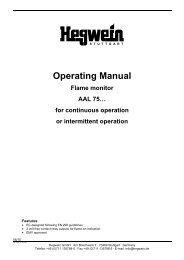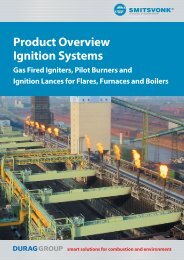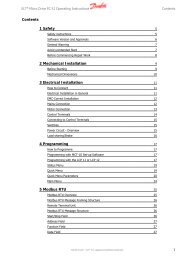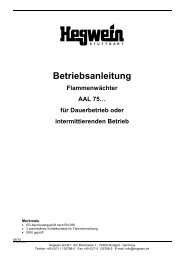Create successful ePaper yourself
Turn your PDF publications into a flip-book with our unique Google optimized e-Paper software.
Page 16 D-<strong>LX</strong> <strong>700</strong><br />
11. G<strong>en</strong>eral Information about the D-LL 703 Fibre Optic System<br />
The D-LL 703 fibre optic system consists of a fibre optic bundle including the l<strong>en</strong>s system (D-FO 703),<br />
an inner carrier assembly with purge air connection and the threaded flame scanner mount (D-IC<br />
703), and an outer carrier assembly including cooling air connection and mounting flange for welding<br />
(D-OC 703).<br />
The forward section of the D-LL 703 fibre optic system carrier compon<strong>en</strong>ts is flexible. This allows the<br />
scanner to monitor the flames of tilting burners. In these applications, the flange of the outer carrier<br />
assembly should be welded to the moving portion of the burner facing the flame. If the burner is<br />
moved up to a new location to distribute heat, the scanner will be automatically adjusted to the new<br />
flame location. Another suitable application for the fibre optic system is for installations that do not<br />
have a direct line of sight from the flame scanner to the burner flame.<br />
These fibre optic systems are available for two differ<strong>en</strong>t spectral ranges: the UV flame scanner D-<strong>LX</strong><br />
703 UA/UAF is compatible with the D-LL 703 UV xx fibre optic systems, and the IR flame scanner D-<br />
<strong>LX</strong> 703 IG/IS is compatible with the D-LL 703 IR xx fibre optic system.<br />
The l<strong>en</strong>s system receives the light from the flame and conc<strong>en</strong>trates it through the fibre optic. The fibre<br />
optics transmits the light directly onto the photo elem<strong>en</strong>t inside the D-<strong>LX</strong> <strong>700</strong> flame scanner.<br />
12. Mounting the D-LL 703/704 Fibre Optic System<br />
To achieve optimal, selective flame monitoring, the correct position must be used to mount either the<br />
welded flange of the D-LL 703 outer carrier tube (flexible system) or the D-LL 704 unit (rigid system).<br />
The s<strong>en</strong>sor must be able to view the flame at any load within the range of the burner. The flame<br />
s<strong>en</strong>sor should also be positioned such that the distance to the selected flame is as short as possible,<br />
and the distance to neighbouring flames is as great as possible. The viewing angle of the flame<br />
s<strong>en</strong>sor should capture the lower third of the flame (the root). Wh<strong>en</strong> selecting the correct position, it is<br />
important to accommodate any normal flame migration, particularly for coal-fired burners. The viewing<br />
axis should not cut through the flames of any neighbouring burners.<br />
Two ½" internal threads have be<strong>en</strong> provided on the fibre optic system, one as a purge air and another<br />
as a cooling air connection. Purge air must be supplied to keep the l<strong>en</strong>s free of possible particulate<br />
accumulation. Therefore, the purge air should be connected to the inner carrier assembly. Only oilfree,<br />
filtered, compressed air should be used for purging.<br />
The D-LL 703 has a connection for cooling air on the outer carrier tube. Enough cooling air should be<br />
supplied to insure that the permissible ambi<strong>en</strong>t temperature for the fibre optics is not exceeded.<br />
If the ambi<strong>en</strong>t temperatures are too high in installations using the D-LL 704 system, a guide tube<br />
should be provided on site that can supply cooling air to the system.<br />
The necessary flow rate, air volume, and pressure required for the cooling air supply must be<br />
determined on a site-specific basis. These specifications dep<strong>en</strong>d on the ambi<strong>en</strong>t temperature, the<br />
l<strong>en</strong>gth of the fibre optic system supplied, the diameter of the guide tube at the burner, and the<br />
temperature of the available cooling air. The l<strong>en</strong>gth of the fibre optic section exposed to higher<br />
ambi<strong>en</strong>t temperatures must also be tak<strong>en</strong> into account. For example, wh<strong>en</strong> a section of the fibre optic<br />
bundle is exposed to the heat from the main burner, less cooling air is required than if the <strong>en</strong>tire l<strong>en</strong>gth<br />
of the fibre optics were exposed to the heat radiating from the main burner or heated combustion air.<br />
Wh<strong>en</strong> the ambi<strong>en</strong>t temperature inside the burner exceeds the permissible ambi<strong>en</strong>t<br />
! temperature of the fibre optic, suffici<strong>en</strong>t cooling air must be supplied at all times. A<br />
failure to meet these criteria can damage to the fibre optic conductors.<br />
The welding flange on the outer guide tube of the D-LL 703 fibre optic system needs to be welded<br />
near the flame in the burner assembly, aligned so it has a clear, precise view of the flame. If possible,<br />
the combustion air supply (primary or secondary wind box) area should be used as the mounting<br />
location.<br />
!<br />
To prev<strong>en</strong>t damage to the fibre optic conductors wh<strong>en</strong> welding the mounting flange<br />
into place, the internal support tube and fibre optics should be removed from the<br />
outer carrier tube before welding.









